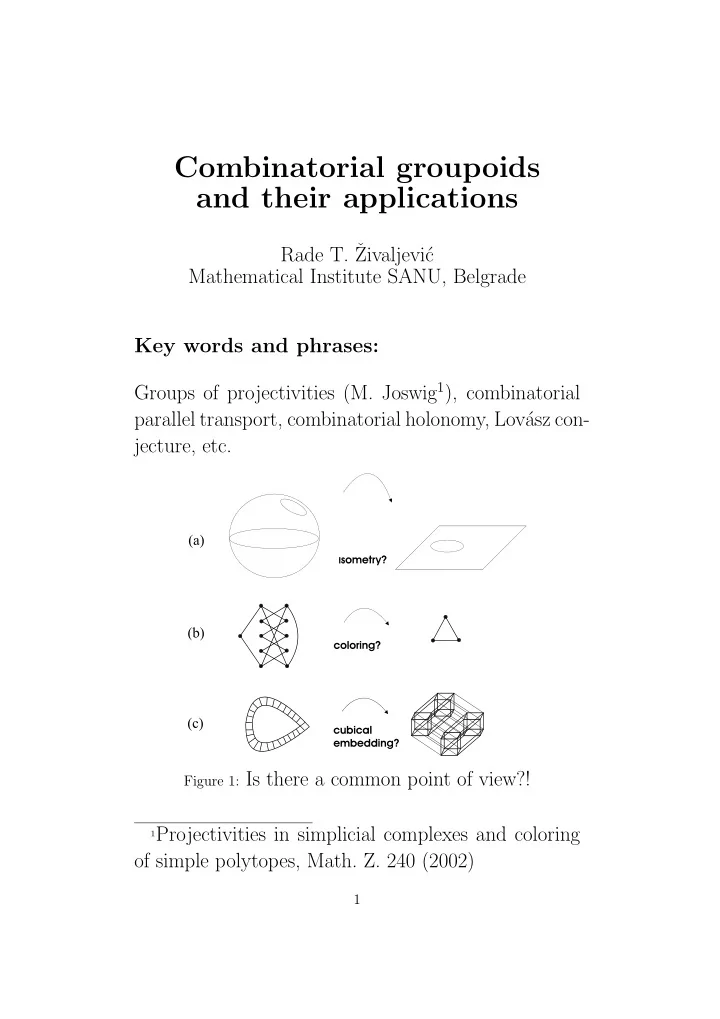

Combinatorial groupoids and their applications Rade T. ˇ Zivaljevi´ c Mathematical Institute SANU, Belgrade Key words and phrases: Groups of projectivities (M. Joswig 1 ), combinatorial parallel transport, combinatorial holonomy, Lov´ asz con- jecture, etc. Figure 1: Is there a common point of view?! 1 Projectivities in simplicial complexes and coloring of simple polytopes, Math. Z. 240 (2002) 1
A positive answer is provided by the theory of groupoids! Figure 2: Groupoids are groups with many objects. The concept of a group is sometimes not sufficient to deal with the concept of symmetry in general. Grou- poids alow us to handle objects which exhibit what is clearly recognized as symmetry although they admit no global automorphism whatsoever. Unlike groups, groupoids are capable of describing reversible processes which can pass through a number of states. For ex- ample according to A. Connes, Heisenberg discovered quantum mechanics by considering the groupoid of quantum transitions rather than the group of sym- metry. 2
First example: Cubical embeddings Figure 3: Cubical complex non-embeddable into a cubical lattice. Theorem 0.1. Suppose that K is a k -dimensional cubical complex which is embeddable/mappable to { R n } ( k ) , the k -dimensional skeleton of the standard cubical decomposition { R n } = { R 1 } n of R n . Then Π( K, σ ) ⊂ BC even for each cube σ ∈ K . Moreover, k if σ ∈ L ⊂ K where L ∼ = { I k +1 } ( k ) is a subcomplex of K isomorphic to the k -skeleton of the ( k + 1) - dimensional cube { I k +1 } , then Π( K, σ ) ∼ = BC even . k 3
Corollary 0.2. The complex K depicted in Fig- ure 3 is not embeddable (mappable) to a cubical lattice (hypercube) of any dimension. Indeed, � � 0 1 ∈ Π( K, σ ) − 1 0 while by Theorem 0.1 only signed permutation ma- trices with even number of ( − 1) -entries can arise as holonomies of subcomplexes of cubical lattices! Figure 4: The effect of a “flip” on the sign characteristic. Figure 5: Parallel transport (flips) of triangles. 4
Problems about cubulations Problem 1 (S.P. Novikov) Characterize k -dimensional complexes that admit a (cubical) embedding (or “im- mersion”) into the standard cubical lattice of R d for some d . Reference: V.M. Buchstaber, T.E. Panov, Torus ac- tions and their applications in topology and combina- torics, A.M.S. 2002. Problem 2: (N. Habegger) Suppose we have two cubulations of the same manifold. Are they related by the bubble moves? Reference: R. Kirby, Problems in low dimensional topology (Problem no. 15), A.M.S. 1995. Definition 0.3. Suppose that K is a k -dimensional cubical complex and Π( K, σ ) its combinatorial holon- omy group based at σ ∈ K . Let I ( K ) = 0 if Π( K, σ ) ⊂ BC even for all σ , and I ( K ) = 1 in the k opposite case. Theorem 0.4. I ( K ) is invariant with respect to bubble moves! 5
Figure 6: Bubble moves. 6
Second example: The Lov´ asz conjecture The general problem is to explore how the topological complexity of a graph complex X ( G ) reflects in the combinatorial complexity of the graph G itself. The results one is usually interested in come in the form of implications α ( X ( G )) ≥ p ⇒ ξ ( G ) ≥ q, where α ( X ( G )) is a topological invariant of X ( G ), while ξ ( G ) is a combinatorial invariant of the graph G . The famous result of Lov´ asz is today usually formu- lated in the form of an implication Hom ( K 2 , G ) is k -connected ⇒ χ ( G ) ≥ k + 3 , (1) where Hom ( K 2 , G ) is isomorphic to the so called “box complex” of G . The box complex is a special case of a general graph complex Hom ( H, G ) (also introduced by L. Lov´ asz), a cell complex which functorially de- pends on the input graphs H and G . An outstanding conjecture in this area, refereed to as “Lov´ asz conjecture”, was that one obtains a better bound if the graph K 2 in (1) is replaced by an odd cycle C 2 r +1 . More precisely Lov´ asz conjectured that Hom ( C 2 r +1 , G ) is k -connected ⇒ χ ( G ) ≥ k + 4 . (2) This conjecture was confirmed by E.Babson and D.Kozlov (math.CO/0402395, to appear in Annals of Mathe- matics). 7
Generalizations Hom (Γ , K ) is k -connected ⇒ χ ( K ) ≥ k + d + 3 (3) Under suitable assumption on the test complex Γ and the assumption that integer k is odd, this impli- cation extends the result of Babson and Kozlov to the case of pure d -dimensional simplicial complexes. (R.ˇ Z, Parallel transport of Hom -complexes and the Lov´ asz conjecture, arXiv:math.CO/0506075 v1 Jun 2005.) Figure 7: Examples of Γ-complexes. Proof: Parallel transport of maps between Hom - complexes over the groupoid J (Γ) introduced by M. Joswig. 8
Update (Anogia, August 20–26, 2005) The complete unfoldings of simplicial complexes (I. Iz- mestiev, M. Joswig 2 ) are put into the context of cov- erings of groupoids (R. Brown 3 ). Example (S. ˇ c, R.ˇ Cuki´ Z) Chessboard complex ∆ k,n is the complete unfolding of the ( k − 1)-skeleton of a ( n − 1)-dimensional simplex. 2 Branched coverings, triangulations, and 3- manifolds, Adv. Geom. 3 (2003). 3 From groups to groupoids; a brief surway, Bull. Lond. Math. Soc., 19 (1987), 113-134. 9
Recommend
More recommend